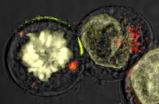Two-thirds of hepatitis C patients can see a cure in half the time, new study finds
Response-guided treatment with drug telaprevir can be shortened to 6 months for many, says research published in New England Journal of Medicine
2011-09-16
(Press-News.org) LOS ANGELES (Sept. 15, 2011) – Treatment with a telaprevir-based combination regimen for hepatitis C – heretofore a chronic, destructive and difficult to manage disease – effectively can be shortened to six months in about two-thirds of patients, finds a new study published Thursday in the New England Journal of Medicine.
Telaprevir, a drug approved for use against hepatitis C in May, inhibits replication of virus. This anti-viral drug and a similar medication called boceprevir have nearly doubled the number of patients with sustained response. Among patients treated with teleprevir, pegylated interferon and ribavirin in the new study, 72 percent were cured of their hepatitis C.
This study shows that two-thirds of patients can be cured in half the time: Patients who are clear of the virus within the first four to 12 weeks of therapy effectively can cut their treatment time from 48 weeks to six months. Besides the considerable benefits to patients of shorter treatment, these findings also show that response-guided therapy is a successful strategy.
"This means that rather than a one-size-fits-all approach, we can individualize treatment for patients based on their specific response to the drugs," said Fred Poordad, MD, chief of Hepatology and Liver Transplantation at Cedars-Sinai and a senior author on the study. "Once you're cured by these anti-viral drugs, you're cured of hepatitis C completely. That's a little known fact among the public – and even among physicians who don't regularly treat liver disease.
Cedars-Sinai is one of the major research sites investigating new treatments for hepatitis C; the medical center is involved in developing most of these new compounds. Earlier this year, Dr. Poordad was the lead author of a study published in the New England Journal of Medicine on the anti-viral drug boceprevir, also an oral protease inhibitor. In that study, 1,097 patients with hepatitis C who had never been treated for the virus received standard treatment – pegylated interferon and ribavirin – for four weeks. Then, a third of the patients continued only on those drugs, while two other groups also received different durations of boceprevir. The boceprevir patients responded well, with 63 percent and 66 percent achieving sustained virus suppression – compared to 38 percent among patients taking only pegylated interferon and ribavirin.
According to the Centers for Disease Control, an estimated 3.2 million people in the United States have chronic hepatitis C virus infections. The disease is spread through virally infected blood, often by sharing of syringes or other equipment to inject drugs; prior to 1990, some infections can be attributed to blood transfusions. Some rare infections can be traced to medical procedures. Chronic hepatitis C is the leading cause of liver cancer and cirrhosis and is the chief reason for the need for liver transplants in the U.S. The disease is linked to as many as 10,000 deaths each year.
In the new telaprevir study, funded by Vertex Pharmaceuticals in Cambridge, Mass., a total of 540 patients were enrolled. They took a 12-week course of 750 milligrams of telaprevir three times a day in addition to therapy with pegylated interferon and ribavirin. Patients eligible for shortened treatment – meaning the virus was not detectable in the first month of treatment – were randomized to receive either 24 weeks or 48 weeks of treatment. The high cure rates among both groups showed that there was no benefit to additional treatment for early responders.
For patients, the shorter course of treatment means decreased costs, fewer side effects and less disruption to their daily lives, as this therapy requires intensive monitoring and laboratory visits.
###
Dr. Poordad has received research grants and served as an adviser and consultant for Vertex Pharmaceuticals, which makes telaprevir, and Merck, which makes boceprevir.
END
ELSE PRESS RELEASES FROM THIS DATE:
2011-09-16
Sabal Financial Group, L.P., formerly Milestone Asset Resolution Company, LLC, a diversified financial services management firm, announces the recent acquisition of a $158 million portfolio of performing and non-performing commercial real estate loans and commercial acquisition, development and construction loans and credit facilities. The acquisition represents the first sale transaction under the FDIC's pilot Small Investor Program ("SIP") and represents the commercial loan component of a larger $297 million loan sale mandated by the FDIC for the assets of failed ...
2011-09-16
Small group homes for people with dementia provide good quality care and a domestic environment where people can live as individuals and families can get involved. But tension can arise when it comes to deciding who takes responsibilities for certain practical and caring tasks.
Those are the key findings of a study of two group living care homes in the Netherlands, published in the September issue of the Journal of Clinical Nursing.
"It's estimated that 80 million people worldwide will suffer from dementia by 2040" says Ezra van Zadelhoff from Maastricht University. ...
2011-09-16
At least one of the "Big Three" credit ratings agencies exaggerated credit scores of private debt compared to public bonds during the last 30 years, according to a new study by researchers from Rice University, American University and Indiana University.
The recent downgrade of U.S. debt by Standard & Poor's makes the study timely, and the research adds to the current debate surrounding regulatory reliance on credit ratings and the current Securities and Exchange Commission proposal to standardize credit ratings across asset classes.
For the study, "Credit Ratings ...
2011-09-16
It has long been known that roots alter the soil in their immediate vicinity, where other microorganisms live and the chemical composition is altered compared to that further away from the roots. An international research team has now demonstrated in experiments at the Paul Scherrer Institute that the soil in the vicinity of roots also contains more water – contrary to the earlier belief that there must be less water in this region, as the plant takes up water from the soil. Apparently, however, plants create a small water reserve that helps to tide them over through short ...
2011-09-16
Tuesday, September 13, 2011, Cleveland: Researchers at Cleveland Clinic have discovered that cardiac patients receiving medicated stents – a procedure that occurs often when blood vessels are blocked – have a lower likelihood of suffering heart attacks or developing new blockages in the vessel downstream from the stent.
Stents have been used to prevent re-narrowing of coronary arteries after balloon angioplasty and newer designs have included coatings with medications to prevent re-narrowing from occurring within the stent after implantation. The recent study – led by ...
2011-09-16
September 2011, Paris, France
The 24th ECNP Congress, which was held from 3 to 7 September 2011 in Paris, France, was once again a great success, bringing together more than 6,700 psychiatrists, neurologists, psychologists and neuroscience researchers from all over the world. ECNP is especially pleased to see an increasing number of delegates coming from outside Europe.
The annual ECNP Congress is the largest scientific meeting on mental and neurological health in Europe, promoting fruitful dialogue between neuroscientists and medical professionals. With more than ...
2011-09-16
Scientists reveal in more detail than ever before how white blood cells kill diseased tissue using deadly granules, in research published today in PLoS Biology.
The researchers, from Imperial College London and the University of Oxford, used 'optical' laser tweezers and a super-resolution microscope to see the inner workings of white blood cells at the highest resolution ever. The researchers describe how a white blood cell rearranges its scaffolding of actin proteins on the inside of its membrane, to create a hole through which it delivers deadly enzyme-filled granules ...
2011-09-16
Are children as young as five years old so driven by consumerism and fashion that they are in danger of 'losing' their childhood?
Not necessarily, according to Dr Jane Pilcher, a sociologist at the University of Leicester, whose research findings on children and fashion were recently reported in the international journal, Childhood.
Nonetheless, her findings showed that brands and logos are highly important to some children, influenced by family attitudes, peer pressure and celebrity culture.
The desire for certain brands and logos, especially in boys' sportswear, ...
2011-09-16
Martha Stokes C.M.T. will be speaking at the AAII Puget Sound Chapter in Mercer Island, WA!
Saturday, September 24, 2011 from 9:00 AM - 12:00 PM.
Registration/Social at 8:30 AM.
The topic will be New Technology Cycle Investing Opportunities.
Attend this meeting and learn:
- Which sectors and industries could experience exponential growth
- Methods for separating the most competitive companies from those that are losing momentum
- The reasons why certain new industries are growing exponentially
For more information please visit:
http://sites.google.com/site/pugetsoundchapter/home
http://technitrader.com/get-connected/
Contact ...
2011-09-16
Their critics weren't convinced the first time, but Rice University researchers didn't give up on the "ice that burns."
A paper by a Rice team expands upon previous research to locate and quantify the amount of methane hydrates -- a potentially vast source of energy -- that may be trapped under the seabed by analyzing shallow core samples. The paper published this week by the Journal of Geophysical Research- Solid Earth should silence the skeptics, the researchers said.
Chemical engineers George Hirasaki and Walter Chapman and oceanographer Gerald Dickens headed the ...
LAST 30 PRESS RELEASES:
[Press-News.org] Two-thirds of hepatitis C patients can see a cure in half the time, new study finds
Response-guided treatment with drug telaprevir can be shortened to 6 months for many, says research published in New England Journal of Medicine

